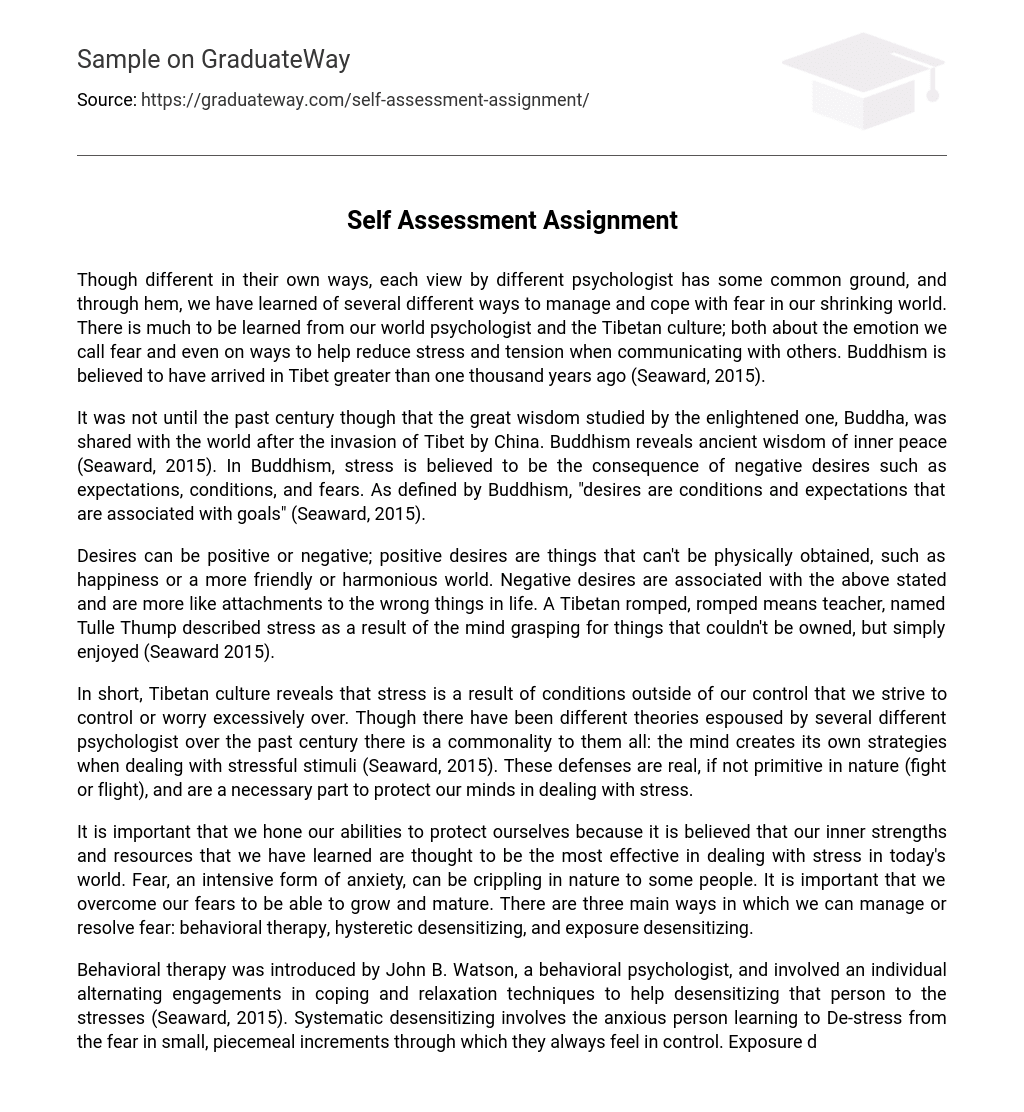Though different in their own ways, each view by different psychologist has some common ground, and through hem, we have learned of several different ways to manage and cope with fear in our shrinking world. There is much to be learned from our world psychologist and the Tibetan culture; both about the emotion we call fear and even on ways to help reduce stress and tension when communicating with others. Buddhism is believed to have arrived in Tibet greater than one thousand years ago (Seaward, 2015).
It was not until the past century though that the great wisdom studied by the enlightened one, Buddha, was shared with the world after the invasion of Tibet by China. Buddhism reveals ancient wisdom of inner peace (Seaward, 2015). In Buddhism, stress is believed to be the consequence of negative desires such as expectations, conditions, and fears. As defined by Buddhism, “desires are conditions and expectations that are associated with goals” (Seaward, 2015).
Desires can be positive or negative; positive desires are things that can’t be physically obtained, such as happiness or a more friendly or harmonious world. Negative desires are associated with the above stated and are more like attachments to the wrong things in life. A Tibetan romped, romped means teacher, named Tulle Thump described stress as a result of the mind grasping for things that couldn’t be owned, but simply enjoyed (Seaward 2015).
In short, Tibetan culture reveals that stress is a result of conditions outside of our control that we strive to control or worry excessively over. Though there have been different theories espoused by several different psychologist over the past century there is a commonality to them all: the mind creates its own strategies when dealing with stressful stimuli (Seaward, 2015). These defenses are real, if not primitive in nature (fight or flight), and are a necessary part to protect our minds in dealing with stress.
It is important that we hone our abilities to protect ourselves because it is believed that our inner strengths and resources that we have learned are thought to be the most effective in dealing with stress in today’s world. Fear, an intensive form of anxiety, can be crippling in nature to some people. It is important that we overcome our fears to be able to grow and mature. There are three main ways in which we can manage or resolve fear: behavioral therapy, hysteretic desensitizing, and exposure desensitizing.
Behavioral therapy was introduced by John B. Watson, a behavioral psychologist, and involved an individual alternating engagements in coping and relaxation techniques to help desensitizing that person to the stresses (Seaward, 2015). Systematic desensitizing involves the anxious person learning to De-stress from the fear in small, piecemeal increments through which they always feel in control. Exposure desensitizing, on the other hand, occurs when the individual is introduced to the real stresses is brief and save encounters with the stresses.
Through combinations of the three different ways to manage fear, it is possible for one to overcome and become a stronger, less anxious, member of society. Communication is important in today’s time yet is often overlooked and not the focal point for many learning systems. Below are just a few ways in which one can improve their own communication skills. Speaking with precision and directness can help set the intent of the message clearly and early on to avoid confusion or misdirection. By enhancing our vocabulary, we enhance the ability to express ourselves and the situation more clearly and effectively.
It is important to remain cognitive of our audience and to use language and vocabulary appropriately. We speak to children differently than we do members in particular professions; it’s important to remember to not use trade words or acronyms when talking to somebody outside of that scope who may not know what the word means. In addition to that, avoid overloading the recipient with too much information, too quickly to avoid having to repeat yourself. The last two go hand in hand; validate our assumptions and resolve problems when they arise (Seaward, 2015).
It’s important to do this to deal with issues as they surface to prevent unnecessary conflict at a later time. Even by implementing one or two of these communication skills we can become better employees, family members, and friends. From Buddha and enlightenment through Moscow and the Hierarchy of Needs and beyond John Watson and behavioral therapy, the human mind and stress has long since been heavy on the mind of man. It is through this burden that we have done extensive research and developed systems to help cope with natural et stressful emotions such as fear and anger.
Every psychologist that did research and proposed theories on stress and the mind have made a difference in some form of way. We have come a long way in understanding our brain and the impact of stress; we’ve still got further to go though.





